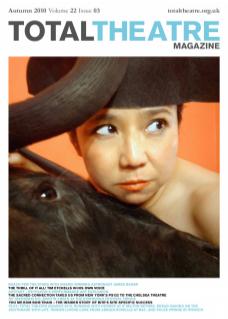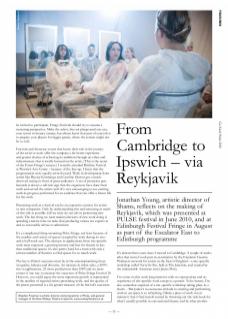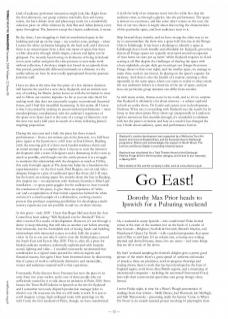It’s almost three years since I moved to Cambridge. A couple of weeks after that move I took part in an initiative by the Escalator Creative Producers network for artists in the East of England – a site-specific workshop called Out of the Box, held at The Junction, and curated by the indomitable American artist Janice Perry.
I’ve come on this week-long intensive with no expectations and no experience of site-specific work except as a punter. To be honest, I’m also somewhat sceptical of a site-specific workshop taking place in a theatre… But Janice’s no-nonsense attitude to creating and performing work in any space is so refreshing (‘Make a piece of work in ten minutes’) that I find myself excited by throwing out the rule book for what’s usually possible in conventional theatre and by what another kind of audience-performer interaction might look like. Right from the first afternoon, our group colonise stairwells, first-aid rooms, toilets, the bar’s drinks store and photocopy room (in a wonderfully salacious piece on office relations by Ania Bas and Adam James); every space throughout The Junction except the theatre auditorium, it seems.
By day three, I am struggling to find an uncolonised space in the building and end up on the stage – my comfort zone, perhaps – when I notice the white cyclorama hanging by the back wall, and I discover there is an unused space here: a slim one-metre of space that faces a white obscurity through which shapes, colours and lights can be glimpsed. I’ve recently been having vivid dreams of living in Iceland seven years earlier and given the time pressure to just make work without reflection, I develop a simple text based on an episode from that period, paradoxically delivered intimately at a distance via the walkie-talkies we have by now totally appropriated from the gracious Junction staff.
I have no idea at the time that this piece of a few minutes duration will become the seed for a new show, Reykjavik, and an entirely new way of working for Shams. Janice leaves us with the invitation to trust and to follow our creative impulses ‘as far as you can take them’ for making work that does not necessarily require conventional theatrical forms, and I find this incredibly heartening. At this point, all I know is that I am excited by making an unconventional performance – more interdisciplinary, installational, with the audience’s experience of the space at its heart, but it is the start of a voyage of discovery over the next two and a half years in search of a from, following Janice’s inspiring proposition.
During the next year and a half, the piece has three scratch performances – from a ten-minute jam at the Junction, to a half-hour piece (again at the Junction) to a full hour at South Street, Reading (with the amazing gift of a three-week funded residency there) and an initial attempt at a complete show. I choose to start the intensive development with a team of designers and a dramaturg in the room as much as possible, and though over the entire process it is a struggle to maintain this relationship with the designers as much as I’d like, this early fortnight (again at The Junction) helps lay a foundation for experimentation – in the first week, Paul Burgess, our set and video designer brings in a pair of cardboard specs like those old 3-D ones, but the lenses are tracing paper. Six months down the line in Reading, this inspires me – in conjunction with Anthony Gormley’s Blind Light installation – to spray-paint goggles for the audience to wear towards the conclusion of the piece, to give them an experience of ‘white out’ and a recapitulation of their initial experience behind the white curtain; it’s a small example of a collaborative, evolving creative process that produces surprising possibilities for developing a multisensory experience just not possible in end-on, sit-down theatre.
At this point – early 2009 - I hear that Roger McCann from the Arts Council has been asking: ‘Will Reykjavik ever be finished?’ This is after a total of five weeks of development. However, it’s not through a desire to keep tinkering that will take us another year before entering final rehearsals, but the formidable task of raising funds and building relationships with interested venues to realise fully the creative vision ‘as far as you can take it’ and to tour the finished piece around the South-East and East in May 2010. This is, after all, a piece for limited audience numbers, technically sophisticated with bespoke sound, lighting and video – I wouldn’t necessarily recommend that combination as a typical modus operandi for obvious logistic and financial reasons, but again I have been heartened since by discovering that if a piece of work is sufficiently distinctive and memorable, venues and audiences respond well to that experience.
Fortunately, Pulse director Steve Freeman has seen the piece in its early form two years earlier, and is one of these people who are sufficiently excited by it to talk about its inclusion in Pulse 2010. Steve locates the Town Hall Galleries in Ipswich as the site for Reykjavik and I somewhat nervously dispatch production manager John to check it out. He reassures me that we will make it work. It is just as you’d imagine: a large, high-ceilinged room with paintings on the wall. Come the first weekend of Pulse, though, we have transformed it (with the help of an immense truss) into the white box that the audience enter, as through a glacier, into the performance. The space is almost too cavernous, and like some other venues on the tour, the first of our two shows is largely about discovering the characteristics of this particular space, and how audiences react to it.
Skip forward three months, and we have swung the other way as we try to accommodate the show into a space half that size in the Bongo Club in Edinburgh. It has been a challenge to identify a space at Edinburgh that is both feasible and affordable for Reykjavik, given that almost all Fringe spaces are typically structured around an equation of ‘max bums on seats per sq metre’ whilst Reykjavik requires no fixed seating at all. But despite the challenges of sharing the space with a busy nightclub, an epic daily get-in and get-out (longer than most Fringe shows in their own right), and the smaller space, we manage to make these work in our favour, by playing on the space’s capacity for intimacy. And there is also the benefit of a routine, running a show repeatedly in the same space, where you come to realise to what extent the way audiences behave is a function of the use of space, and just how one particular group dynamic can differ from another.
As with many artists, themes recur in my work, and so it’s no surprise that Reykjavik is ultimately a lot about memory – a subject explored in both an earlier show, The Garden and a piece now in development, Darkroom. What was so rewarding with Reykjavik was the search for its form, so that when Janice Perry shows up unexpectedly in London in April to attend our first stumble-through, it’s wonderful to celebrate with her the piece’s evolution and how as a result it has changed the way I think about audience, space and performance forever.
Reykjavik’s creative development was supported by a Wellcome Trust Art Award, Arts Council England East, and the Escalator East to Edinburgh programme. Shams also acknowledges the support of South Street, The Junction and Dance Digital in providing rehearsal space.
Reykjavik was shortlisted for a Total Theatre Award at the Edinburgh Festival Fringe 2010 in the Innovation category, and is due to tour nationally in Spring 2011.
More details of this and the company’s other work at www.shams.org.uk


